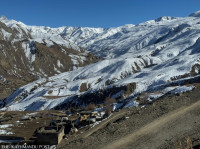Karnali Province
Legally unmarried, socially married
In Karnali, early marriages, driven by a host of factors, are rampant, which have multiple consequences, especially on girls.
Aakriti Ghimire
Five years ago, PR and YB met in their school, Mahadev Secondary School in Gurnas Rural Municipality, Dailekh.
PR was 15 and YB 17 when they met. They fell in love and eloped to get married.
YB’s mother Mandira herself was married at the age of 17. However, she distinguishes between her marriage and her son’s.
“My parents married me off, it was an arranged marriage. But nowadays, parents don’t marry their children off early, it is children themselves who run away at ages as early as 14/15,” says Mandira, who runs Purnel Gurans Guest House in Tallo Dungeshwar, Dailekh.
The marriage of PR and YB, whom the Post is identifying with their initials to protect their identities, is just a case in point. Child marriage is rampant across Karnali Province. As opposed to parents forcing children to marry as seen in earlier days, children in the region choose their partners, elope with them and many perform “self-initiated marriages”.
Despite interventions by parents to separate their children, teenagers either elope again or give their parents a suicide scare, which forces parents to allow the children to live together without legally marrying.
Experts working in local non-governmental organisations (NGOs) from Jumla to Dailekh describe this growing trend of elopement and self-initiated marriages as a consequence of a search for love, safety and belongingness from the family, a lack of comprehensive sexuality education (CSE) and a sociocultural environment that encourages children to elope.
“Over the years of my work, I have found that teenagers here are confused about their future and believe marriage to be the end of it all. In particular, many young girls are in search of love, safety and a sense of belonging. And when they find that through their male companions, they decide upon marriage,” says Sajana Sunar, programme coordinator at Social Service Center (SOSEC), a local NGO working in the field of child rights and child protection.
Additionally, there is little to no conversation about adolescence, puberty and sexual attraction at all. Such a lack of conversation around sex makes adolescents misinformed about sexual attraction and desires.
Since they see marriage as a way to act on their desires, it leads to them eloping or performing self-initiated marriages, according to Sunar.
“Given that our society views marriage as license to have sex, adolescents go along with their feelings and attractions, and elope,” she says.
As per the National Civil Code Act 2017, the legal age of marriage is 20 for both boys and girls. The marriageability age was increased so that young people can finish school, become independent and mature before they can make informed marriage choices. As per Section 173 of the Criminal Code, a person found guilty of either committing or arranging a child marriage is subject to a jail term of up to three years and a fine of Rs30,000.
Despite child marriage being illegal—it was banned in Nepal in 1963—the practice has been rampant in the country, fuelled by a complex host of factors including poverty and discrimination. But there has been this new trend picking up among adolescents who are choosing their partners on their own and eloping.
Their decisions, however, do not exist in a vacuum. Those working with different NGOs say this trend of early marriage is also increasing because teenagers often tend to follow what they see around, that is the normalisation of elopement and self-initiated marriages.
In some cases, parents also want their sons to “bring wives” to help them with household chores and farm work, which is the majority of the population’s livelihood, according to Jayalaxmi Chaulagain, who works as a field officer in Collaborative Actions for Dignity (CAD) Nepal, a local NGO working in rural development in Jumla.
There’s an insidious culture of encouraging sons to get married before they leave the village to pursue higher education or in search of jobs, experts say. Adding to that, negligence in the upbringing of young girls creates a sociocultural environment that promotes child marriage in the region.
To escape the legal provisions, children elope but do not get married—customarily or legally. Girls instead cohabit with the boy’s family and get “officially” married once they turn 20.
PR and YB, who were 15 and 17, respectively when they eloped, got married after PR turned 20.
“If any person from SOSEC comes, families identify their daughters-in-law as a distant relative and not their son’s partner,” says Mandira, the boy’s mother.
When organisations like SOSEC, the police or even the family members attempt to separate the children, they are often met with unpredictable reactions.
“Children say ‘if I don’t get to marry, I’ll commit suicide.’ When children threaten that way, the parents allow them to cohabit, and even marry at times,” says Chaulagain, who also oversees the Lead and Decide project under Plan International Nepal.
In Septi village, Gurans Rural Municipality, a young girl aged 17 fell in love with a 19-year-old boy studying Junior Technical Assistant. They eloped. But when their families separated them, the girl threatened to commit suicide.
Another girl aged 16, in similar circumstances, lost her life while she was faking an attempt to commit suicide, according to Mandira.
“In such instances, parents are scared to lose their child, so they allow cohabitation, and also marry the children customarily as well,” says Chaulagain.
Experts also share that there are various instances of child marriage that take place ritualistically in the villages as well. However, there are no cases filed because local leaders are scared to lose their political support in the region. As opposed to politics becoming a tool to combat such social scourge, it is instead encouraging leaders to turn a blind eye to it, according to them.
SOSEC actively works in eight rural municipalities in Dailekh, Achham, Kalikot and Surkhet. According to them, the realities of child marriage across the region echo the same cause, process and consequence.
Experts say children are at the brunt of a lack of accurate information on sex and sexual attractions. As a consequence, adolescents engage in unprotected and unsafe sex, with minimal to negligible information on contraceptives or family planning.
Children who either are customarily married or cohabiting become parents early. PR and YB have a baby boy now who will turn two in three months.
SB, 20, eloped with her husband while she was 16, a ninth-grader, in Surkhet. She is a mother of a one-year-old child. Another 21-year-old girl eloped at the age of 15. She has a three-year-old child.
The majority of children born out of early marriages are not healthy.
Karnali has the highest neonatal mortality rate compared to other provinces. There were 863 cases of early-stage abortion in 2020 alone in Jumla, according to Chaulagain.
Additionally, the girl has to take on all the responsibilities of household work, and the boy has to shoulder the responsibility for his partner and child, both at such young ages.
“Their education is impacted, their mental health is compromised and sometimes the family relationships become extremely difficult for the children to navigate,” says Sunar, at SOSEC. “And both of them are immature, so looking after their children also becomes an added responsibility.”
To raise awareness about the laws against child marriage among the youths, songs such as ‘Balakhai ma dil basyo Gauthali’ has also been released. The song, sung by a child artist, is contextualised in Karnali Province through the use of local dialect, accent and references to places such as Dailekh, Karnali bridge and Surkhet.
The lyrics of the song go –
“my heart fell for yours, Gauthali, as a child
my heart is desperate to run away with you,
if we do, a case of child marriage will be filed against us.”
The 21-year-old who eloped at 15 says it is only in the past year that advocacy efforts against child marriage have sped up.
SOSEC has made a counsellor available through their child helpline. They counsel children who are likely to be married. For children who have already been married, they encourage separate living by counselling both parties throughout. In addition, they also provide counselling support to families.
To address the lack of education on adolescents’ bodies and rights, Plan International has established sexual and reproductive health and rights (SRHR) centres within schools in Jumla, Sinja valley and Hima (Kanakasundari). For about 10 months, twice every week, they provide students with information on SRHR, self-defence and the ways to report any violence against their child rights and SRHR.
Despite these efforts, the socio-cultural normalisation of child marriage—and acceptance of cohabitation as a norm—has led to the continuation of the practice, according to experts.
An internal survey by SOSEC under their child protection programme indicates about 36 percent decline in child marriage cases out of all the registered marriage data thus far. However, in light of the current practices of cohabitation, there is no record of such living situations available.
Locals have found a legal loophole in keeping the practice alive, they say.
All the girls the Post spoke to, who got married at a young age, have discontinued their education. The girls are extensively involved in household chores and have no means of becoming financially independent.
YB works at a garage near his parents’ hotel.
“Had YB and PR received adequate counselling about their adolescent phases in life, sexual attraction and any form of sex education,” says Mandira, “perhaps they would still be in school.”




 8.12°C Kathmandu
8.12°C Kathmandu












